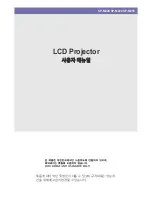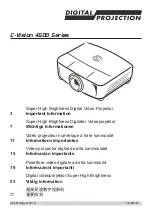
A CONSUMER GUIDE:
CHOOSING THE RIGHT
BY
NEC
Solutions America
FOR YOUR
HOME
Consumers are increasingly smitten by the beautiful, brilliant images and sleek, flat-screen designs offered from
plasma displays. Their sleek profile and extremely wide viewing angle addresses the functionality requirements
of rooms with minimal space, such as a living room, loft or even a bathroom. Plasma displays meet the rigorous
requirements of the most discerning home theater enthusiast, with brilliant image quality, accurate image repro-
duction and amazing brightness and contrast.
A PROJECTOR
can offer the same vibrant, larger-than-life viewing experience as going to the movies while
being considered an attractive, practical display option for consumers. Many home entertainment projectors are
available in a compact, contemporary design that can be discreetly mounted to a wall or ceiling, but are adapt-
able enough to be removed from the room for other uses, like projecting the latest sci-fi thriller on the garage
door for neighborhood movie night.
HERE’S THE REAL BEAUTY OF LARGE SCREEN DISPLAYS:
due to their broad
signal compatibility, they offer capabilities that span far beyond a traditional TV, such as high
definition television, cable and satellite display. They can also be used for gaming, digital
pictures, computers and more. Research indicates that large screen display products are
here to stay. According to Home Theater Research Group, the plasma display market is
projected to grow 70% annually over the next three years and IDC predicts that home theater
projectors are expected to move from 9% of the overall projector market in 2004 to 20% by 2008.
LARGE SCREEN DISPLAY
Have you been dreaming about converting the living room into a decorative yet usable space?
The couches, window treatments and paint are certainly important. But, selecting the right
large screen display to complete the room may be the most critical task ahead whether you are
a first-time buyer of the technology or home entertainment aficionado.
Today, there are an abundance of display choices available for the home beyond traditional TVs. A flood of new
technologies -- such as flat screens and lightweight projectors can be found in a wide range of screen sizes and
prices to fit virtually every room of the house.
ARE YOU LOOKING TO TRANSFORM YOUR BASEMENT INTO A
HOME THEATER
?
HT
410
front glass substrate
display electrode
phosphor
grid barrier rib
rear glass substrate
black stripe
data electrode
Plasma display panels consist of two thin panels of mounted
glass found within the screen. The panels are made up of an
array of cells, known as pixels, which are tiny pockets composed
of compressed gas. Each pixel contains three sub pixels made up of
red, green and blue phosphors.
When an electrical current is applied to a pixel, the gas reacts to form plas-
ma, which in turn produces UV light. The light reacts with the phosphors to
produce the colors you see on the screen. Because all the pixels emit light at
the same time, the viewers never see a flickering screen.
Pixel:
The smallest discrete component of an image or picture on a screen (usually a colored dot); "the greater
the number of pixels per inch the greater the resolution." -- WordNet ® 2.0, © 2003 Princeton University
Projectors are categorized into the following two primary technologies, which reference the internal mechanisms
used to compose an image:
LCD (LIQUID CRYSTAL DISPLAY)
projectors contain three separate LCD glass panels, one for red, green, and blue
components of the image. As light passes through the LCD panels, individual pixels can be opened to allow light
to pass or closed to block the light. This activity modulates the light and produces the image that is projected onto
the screen. LCD advantages include images with deep saturated colors that are sharp and accurate, bright
images and low costs for greater affordability.
DLP (DIGITAL LIGHT PROCESSING)
Developed by Texas Instruments, the DLP chip is a reflective surface made up
of thousands of tiny mirrors. Each mirror represents a single pixel. In a DLP projector, light from the projector's
lamp is directed onto the surface of the DLP chip. A color wheel consisting of red, green, blue and sometimes
clear segments spins between the lamp and the chip to modulate the color. The mirrors move back and forth,
directing light either into the lens path or away from the lens path. DLP technology offers a very high contrast
ratio, with less space between pixels (reduces screen door effect) for smoother images, along with fewer
components, allowing the projector to be packaged into an extremely compact design.
WHAT IS A PLASMA DISPLAY AND HOW DOES
IT WORK?
LCD
AND
DLP
™
PROJECTOR TECHNOLOGIES. WHAT’S THE DIFFERENCE?
For more information on NEC’s industry-leading large screen displays,
please contact us at 800 NEC-INFO or visit www.necvisualsystems.com
The opinions expressed in this document are those of NEC Solutions America,
Inc., based on the current state of large screen display technologies as of
September 2004.
NEC 090403
NEC is a registered trademark of NEC Corporation. All other trade-
marks are the property of their respective owners. All specifications
and programs are subject to change without notice. DLP
™
is a
trademark of Texas Instruments.
©2004 NEC Solutions (America) Inc
Visual Systems Division
1250 Arlington Heights Rd., Suite 400
Itasca, IL 60143-1248






















